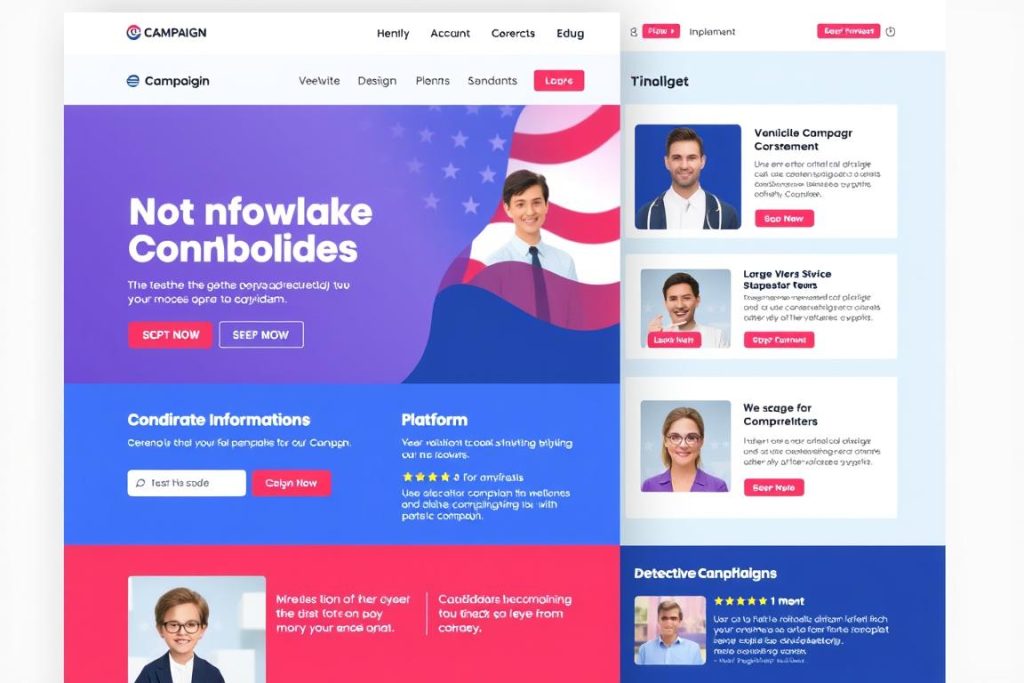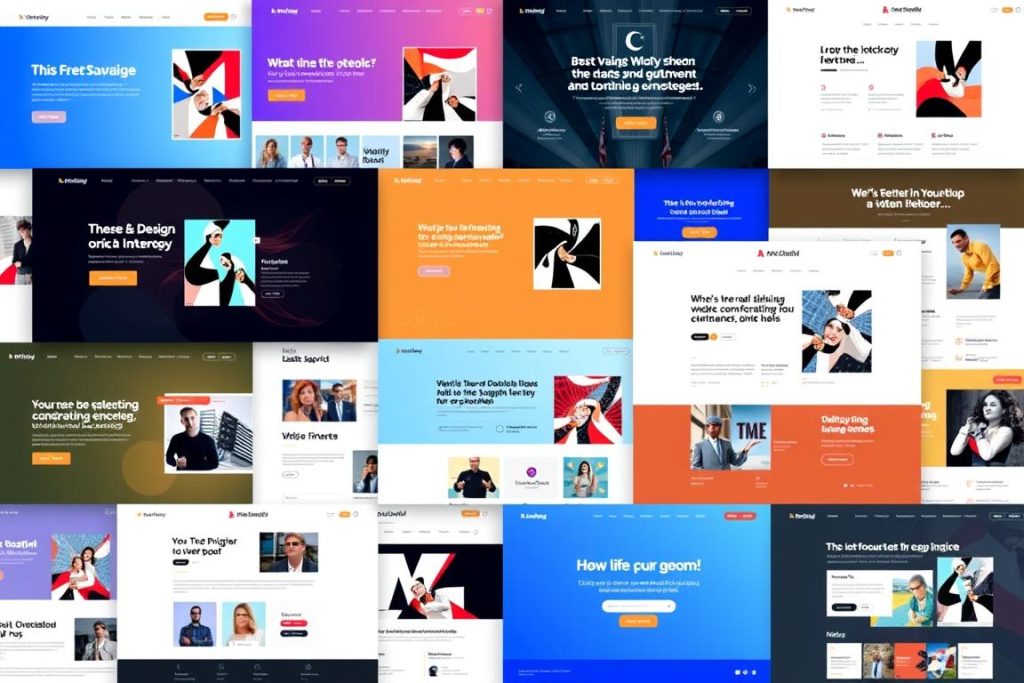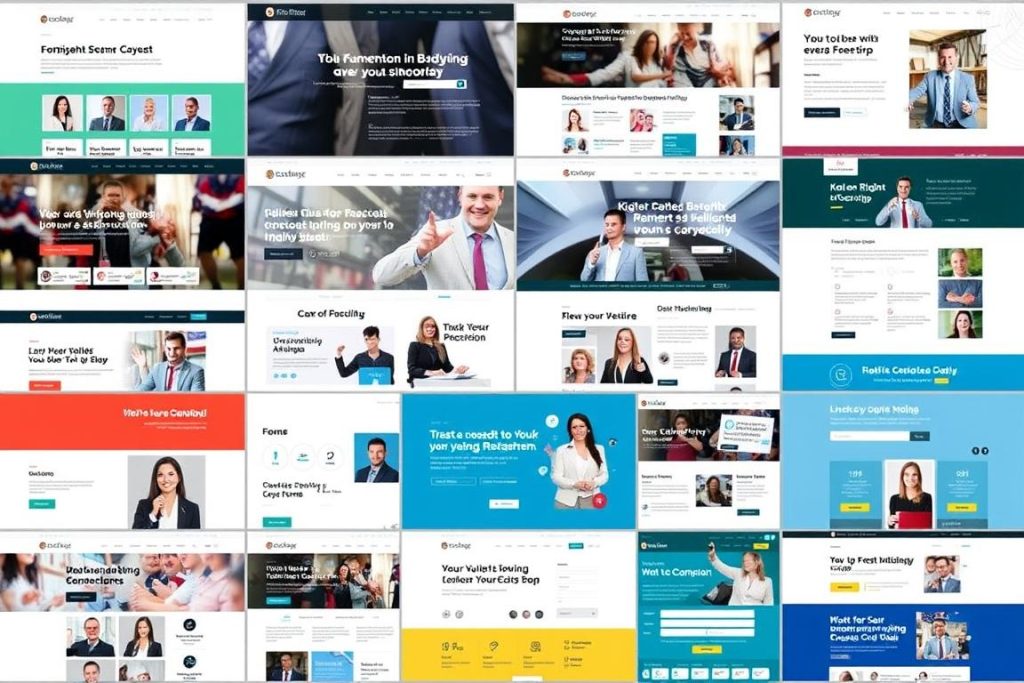Did you know that over 60% of campaigns fail because of bad websites? This shows how significant a good online presence is. Using a strong campaign site template is key.

The proper campaign templates make a big difference for politics, non-profits, or business. This guide helps you create a strong online presence. It covers campaign example draw strategies and website templates. It’s for everyone, from experienced marketers to newbies.
Key Takeaways
- Over 60% of campaign efforts fail due to poorly designed websites.
- Effective campaign templates are crucial for campaign success.
- Diverse templates serve political, non-profit, and commercial campaigns.
- Strategic campaign example draw techniques enhance engagement.
- This guide aids in selecting, customizing, and optimizing the best templates.
Introduction to Campaign Website Templates
Starting a campaign means having a strong online presence, which is key. That’s where campaign website templates come in. They offer a pre-made framework that includes all the must-haves for a campaign site. This lets campaigners focus on their message and strategy, not design details.
What Are Campaign Website Templates?
Campaign website templates are ready-to-use designs that include important parts like homepages, donation forms, and social media links. Thus, they make it easy to set up a campaign site quickly.
Importance of Using Templates for Campaigns
Using templates for campaigns has many benefits. They ensure the site looks professional and consistent with the campaign’s brand. They also save time and resources, letting campaigners focus on strategy.
Templates are also vital for creative marketing campaigns. They help set a tone and connect with the audience. Many successful campaigns, like political ones and fundraising efforts, have used templates to significant effect.
The Anatomy of a Successful Campaign Website
A successful campaign website mixes key elements, innovative design, and user experience. Examples of successful campaign websites show us what makes them stand out.
Key Elements to Include
An effective campaign website has several important parts. These parts work together to meet the campaign’s goals:
- Clear Messaging: Your website should have a clear and concise message that speaks to your audience.
- Compelling Visuals: Good images and videos grab attention and show what your campaign is about.
- Call-to-Action (CTA): Strong CTAs push visitors to take action, like donating or supporting your campaign.
Design and Layout Tips
Design and layout are key to a website’s success:
- Visually Appealing Interface: The website should look good and match your brand.
- Consistency: Use the same colors, fonts, and styles to strengthen your message.
- Coherence: The website should flow well, making it easy for users to move from one section to another.
User Experience Considerations
User experience is crucial for a successful campaign website. Good UX leads to happy users and more engagement:
- Intuitive Navigation: Navigation should be easy, letting users find what they need quickly.
- Fast Load Times: Make sure your website loads fast. Slow websites can make users leave quickly.
- Responsive Design: Your website should work well on all devices, giving users a smooth experience.

Examples of Campaign Websites
Campaign websites have different goals. They aim to achieve specific objectives. Various examples can show how each type works best.
Political Campaign Websites
Political sites aim to build trust and motivate people to act. BaracObama’s 2008 and 2012 sites are great examples. They used social media, a strong story, and clear calls to action to get voters involved.
By using creative marketing, these sites engage and educate supporters. This encourages them to take action.
Non-Profit Campaign Websites
Non-profit sites aim to educate, motivate, and collect donations. The association’s Ice Bucket Challenge is a perfect example. Its interactive design and user content raised awareness and money.
These sites share success stories and testimonials and show progress. They use emotional appeals to encourage donations.
Commercial Campaign Websites
Commercial sites aim to turn visitors into buyers. ThCoca-Cola’s ‘Share Coke’e’ campaign is a great example. It lets users create personalized Coke cans, boosting engagement and sales.
These sites focus on a good user experience and creative marketing. They offer personalized content to connect with their audience and drive sales.

| Campaign Type | Goals | Key Features | Example of a Campaign |
|---|---|---|---|
| Political | Engender Trust and Drive Action | Social Media Integration, Compelling Narrative, Calls-to-Action | BaracObama’s’s CBaracObama’s |
| of it | Inform, Inspire, Solicit Donations | Interactive Design, User-Generated Content, Progress Bars | Ice Bucket Challenge |
| Commercial | Convert Visitors into Customers | Personalized Content, Engaging User Experience | ‘Share Coke’e’ Campaign |
How to Choose the Right Campaign Website Template
Choosing the right campaign template is key to the success of any online campaign. The template should match the campaign’s campaign.
Start by thinking about what your campaign needs. Consider its goals, what’s for, and what and what it says. Changing design and content can make the template fit your campaign’s campaign, which is essential to meet the campaign.
Evaluating Template Functionality
Look at how well a marketing campaign sample works. Check it. It’s easy to use if you can change it a lot, and it’s good if the template is easy to navigate, lets you customize, and has strong support. This helps your campaign look professional and run smoothly.
Here are some things to think about when choosing:
- Does it work with your content management system?
- Is it good on all devices?
- Can you customize it a lot?
- Is there good support and help?
| Feature | Importance | Notes |
|---|---|---|
| Responsive Design | High | Ensures optimal viewing on all devices. |
| Customization Options | Medium | Allows personalization to reflect campaign branding. |
| Support and Documentation | High | Provides guidance and help for any issues. |
Creative Marketing Campaign Website Templates
Creative marketing campaigns are key for businesses to grab and keep their audiences. A designed website template can significantly impact a campaign’s success campaign. Explore some campaigns with their unique website designs.
- Bold Visuals: Dynamic images and bold fonts create intense feelings, making the campaign eye-catching.
- Interactive Elements: Features like animations and infographics give users a profound experience.
- Storytelling: A good story on the website helps users connect and remember the campaign.
Now’s see how elements work together:
| Component | Description | Impact |
|---|---|---|
| Bold Visuals | High-resolution images, dynamic typography | Captures attention, evokes emotion |
| Interactive Elements | Animations, interactive graphics | Increases engagement |
| Storytelling | Consistent theme, narrative-driven content | Boosts connection and retention |
In short, the top creative campaign website templates mix these key elements for exceptional digital experiences. By using these templates, businesses can make their campaigns not just noticed but also meet their goals.
Campaign Example Draw: Success Stories and Templates
Looking at successful campaign templates can teach us a lot. We can determine what makes a campaign work by studying different success stories. Let’s explore these key elements to see how they make a difference.
Analyzing Successful Campaigns
Many campaigns have set high standards in the industry. BaracObama’s 2008 campaign is a top example of digital success. It used new digital ways to reach voters and strong social media to connect.
We can learn about targeting, messaging, and how to engage people by looking at these campaigns.
- BaracObama’s 2008 Campaign: Used digital platforms to great success.
- ALS Ice Bucket Challenge: Showed how viral content can raise awareness and funds.
- OlSpice’s'” “The Man Your Man Could Smell Li” e” Highlighted the power of humor and creativity in ads.
Template Breakdowns
Knowing the structure of successful campaign templates can help us achieve similar results. Let’s take a closer look at some well-known templates:
| Campaign | Key Features | Results |
|---|---|---|
| Obama 2008 | Comprehensive digital strategy, data-driven targeting, and strong social media presence | High voter engagement, landmark electoral victory |
| ALS Ice Bucket Challenge | Viral challenge, user-generated content, social media integration | $115 million raised, widespread global participation |
| Old Spice Campaign | Humorous tone, engaging video content, direct user interaction | Significant increase in sales, brand revitalization |
By studying these examples, marketers can find and use successful campaign templates to improve their campaigns. Key elements like innovative digital strategies, engaging content, and good audience interaction can produce great results.
Building a Campaign Website from Scratch
Creating a custom campaign website from scratch is rewarding. It’s key to have a unique online presence that shows your campaign’s values and vision. A custom site offers more flexibility and a personal touch than a generic campaign site template.
First, figure out your brand identity to customize a campaign website well. Your site should share your message and connect with your audience. Focus on these key areas for a that’s both cohesive and engaging:
- Branding: Create a consistent look with your campaign colors, logos, and graphics.
- Content Creation: Write compelling content that tells your story and mission. Use great images, videos, and infographics to make your story pop.
- Technology Integration: Use modern web tech to make your site fast and responsive. Choose a content management system for easy updates and a professional look.
- Strategic Planning: Set clear goals and actions for your website,e e.Whether you’re looking for donations or volunteers, your site should guide visitors to these actions.
By adding these elements, you can make your site more than just a campaign site template. You can customize your campaign website to stand out. Make sure everything supports your campaign’s goals and offers a smooth user experience.
Tips for Optimizing Your Campaign Website
Optimizing your campaign website is key to keeping users engaged and boosting conversion rates. Here are some top strategies for better campaign website optimization:
First, make sure your site loads quickly. A fast site keeps users from leaving and improves their experience. Use tools like Google PageSpeed Insights to find and fix slow spots. Compress images, use browser caching, reduce down on CSS, and speed things up.
Also, make sure your site works well on all browsers and devices. Test it on different platforms with tools like BrowserStack to find and fix any problems. Don’t forget to optimize your calls-to-action (CTAs). Clear and compelling CTAs can improve campaign site performance. Try different designs and texts to see what works best using A/B testing. It’s also essential to have a responsive design for mobile users. With more people browsing on phones, a responsive design ensures your site looks and works great on all screens. This boosts engagement on mobile devices.
For data-driven improvements, use analytics tools like Google Analytics. Track things like time on site, page views, and conversion rates. This helps you understand what’s working and what needs tweaking.
Finally, keep your content fresh and your site secure. New content keeps users interested, while strong security builds trust and keeps your site safe from threats.
By following these tips, you can significantly improve your campaign website optimization. This will lead to better performance on your campaign site.
Common Pitfalls to Avoid in Campaign Website Design
Campaign website design is key to success. Yet, common mistakes can hurt your efforts. Knowing these pitfalls and avoiding them can boost your campaign’s impact.
Poor Mobile Optimization
In today’s world, a responsive campaign site is essential. Many people use mobile deviceto s visit websiteusing visitit websites., anmobile-sitete isn’t mobile-friendly, you’ll.
Make sure your site works well on mobile. It should be easy to use, load quickly, and look good, which will keep visitors interested and engaged.
Ignoring SEO Best Practices
Not focusing on SEO for campaign websites can hurt your visibility. SEO helps your site rank higher in search results. This makes it easier for people to find you.
Use the right keywords, optimize meta tags, and create valuable content. Without these steps, your site may get lost among competitors.
Overlooking Analytics
Finally, ignore website analytics. They help you understand how users interact with your site. Analytics show which pages are most popular and where people leave.
This data is crucial for improving your site. Check and use this information regularly to enhance your online presence.
Conclusion
Creating a strong campaign website is more than picking pretty templates. It’s about combining good design, ease of use, and focused content. This guide has covered key points, from the role of templates to what makes a site successful.
Choosing the right templates for your campaign is key. You should check their features and learn from others’ successes. These steps will improve and enhance your website.
Building a website that looks good and works well is crucial. Use the tips from this article to make a site that connects with your audience. This will help your campaign succeed.
FAQ
What are campaign website templates?
Campaign website templates are pre-made designs for starting a campaign’s online site. They make creating a site easier by including important parts, letting campaigners focus on their message and plan.
Why is it important to use templates for campaigns?
Templates save time and make sites look professional. They also include key elements that might be missed. They set the tone for marketing and are the first thing people see.
What are the key elements to include in a campaign website?
A good campaign site has clear messages, eye-catching visuals, and a strong call to action. It should be easy to use and work well on all devices. These features help the site work well and meet its goals.
Can you provide examples of campaign websites?
Yes, there are many types. Political sites build trust and action, non-profit sites inform and request donations, and commercial sites aim to sell. Each type needs a unique approach based on its goals.
How do I choose the right campaign website template?
First, think about what your campaign needs. Look at templates for their ease of use, customization, and support. Choose one that fits your campaign’s goals and makes it easy for users.
What are the considerations for optimizing a campaign website?
To optimize a site, it must be fast, work on all browsers, and have clear calls to action. It should also use SEO well. These steps help users enjoy the site more and can lead to more actions.














